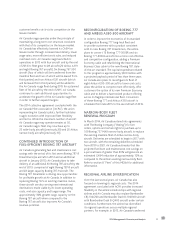Air Canada 2014 Annual Report Download - page 21
Download and view the complete annual report
Please find page 21 of the 2014 Air Canada annual report below. You can navigate through the pages in the report by either clicking on the pages listed below, or by using the keyword search tool below to find specific information within the annual report.
21
2014 Management’s Discussion and Analysis 21
2014 Management’s Discussion and Analysis
aircraft in 2014 and the unfavourable impact of a
weaker Canadian dollar as at December 31, 2014
compared to December 31, 2013 on Air Canada’s
foreign currency denominated debt (mainly
U.S. dollars), which accounted for an increase
of $365 million to long-term debt in 2014. The
airline’s adjusted net debt to EBITDAR ratio was
3.1 at December 31, 2014 versus a ratio of 3.0 at
December 31, 2013. Air Canada uses this ratio to
manage its financial leverage risk and its objective
is to maintain the ratio below 3.5. Adjusted net
debt (total debt less cash, cash equivalents and
short-term investments plus capitalized operating
leases) is a non-GAAP financial measure. Refer to
section 9.3 “Adjusted Net Debt” of this MD&A for
additional information
• Unrestricted liquidity (cash, short-term
investments and undrawn lines of credit) of $2,685
million at December 31, 2014 (December 31,
2013 – $2,364 million). Unrestricted liquidity
refers to the sum of cash, cash equivalents,
short-term investments and the amount of
available credit under Air Canada’s revolving credit
facilities. At December 31, 2014, cash and short-
term investments amounted to $2,275 million
and undrawn lines of credit amounted to
$410 million. At December 31, 2013, cash and
short-term investments amounted to $2,208
million and undrawn lines of credit amounted to
$156 million. Air Canada’s principal objective in
managing liquidity risk is to maintain a minimum
unrestricted liquidity level of $1.7 billion
• Return on invested capital (“ROIC”) at
December 31, 2014 of 12.1% versus 10.5% at
December 31, 2013. Air Canada’s goal is to achieve
a sustainable ROIC of 10% to 13% by 2015. Refer
to section 20 “Non-GAAP Financial Measures” of
this MD&A for additional information
Fourth Quarter 2014 Financial Summary
The following is an overview of Air Canada’s
results of operations and financial position for the
fourth quarter of 2014 compared to the fourth
quarter of 2013.
• Operating revenues of $3,104 million, an
increase of $210 million or 7% from the fourth
quarter of 2013
• An ASM capacity increase of 8.5% from the
fourth quarter of 2013, in line with the 7.75% to
8.75% capacity increase projected in Air Canada’s
news release dated November 6, 2014. The
capacity growth in the fourth quarter of 2014
was primarily driven by increased seat density
from Air Canada rouge and the introduction of
six Boeing 787 aircraft and one higher-density
Boeing 777 aircraft into the mainline fleet
• Passenger revenues of $2,755 million, an increase
of $195 million or 7.6% from the fourth quarter
of 2013, on traffic growth of 9.4% partly offset
by a yield decline of 1.9%. An increase in average
stage length of 2.2% had the effect of reducing
system yield by 1.2 percentage points. On a stage
length adjusted basis, system yield decreased 0.7%
year-over-year
• A PRASM decline of 1.2% from the fourth quarter
of 2013, as the 1.9% decline in yield was partly
offset by a passenger load factor improvement of
0.6 percentage points
• The favourable impact of a weaker Canadian dollar
on foreign currency denominated passenger revenues
increased passenger revenues by $33 million in the
fourth quarter of 2014. The unfavourable impact
of a weaker Canadian dollar on foreign currency
denominated operating expenses (mainly U.S.)
increased operating expenses by approximately
$89 million in the fourth quarter of 2014
• An adjusted CASM which was unchanged from the
fourth quarter of 2013 versus the 1.0% to 2.0%
decrease projected in Air Canada’s news release dated
November 6, 2014. This difference was primarily due
to higher than forecasted employee benefits expense
mainly due to revised actuarial valuations related to
pension and post-employment benefits, an increase
in accruals related to employee profit sharing
programs, the timing of maintenance events versus
what was previously projected and, to a lesser extent,
the impact of a weaker than anticipated Canadian
dollar. Adjusted CASM is a non-GAAP financial
measure. Refer to section 20 “Non-GAAP Financial
Measures” of this MD&A for additional information
• Operating income of $106 million compared to
operating income of $135 million in the fourth
quarter of 2013, a decrease of $29 million. In
the fourth quarter of 2014, one-time payments
totaling $30 million were made to ACPA members
pursuant to the ACPA collective agreement
concluded in October 2014. In the fourth quarter
of 2013, Air Canada recorded an operating expense
reduction of $82 million related to amendments to
defined benefit pension plans. Air Canada reported
an operating margin of 3.4% compared to an
operating margin (excluding the impact of benefits
plan amendments) of 1.8% in the fourth quarter of
2013, an improvement of 1.6 percentage points
























